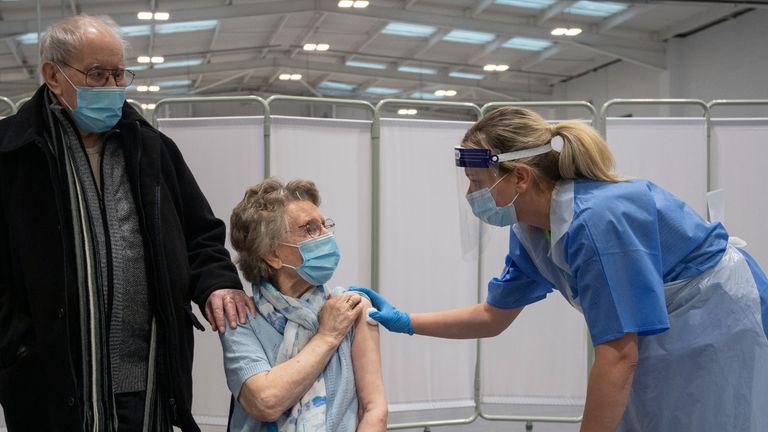Almost four in five of those aged over 80 have received a first dose of a COVID vaccine, Health Secretary Matt Hancock has said.
Speaking at a Downing Street news conference, Mr Hancock said the government was “on track” to meet its deadline of offering a first dose of a coronavirus jab to 15 million of the most vulnerable by 15 February.
Live COVID news from UK and around the world
He said more than one in nine of the UK’s adult population had now received a jab, including 78.7% of all over-80s.
Over the last week, 2.5 million got a vaccine at a rate of more than 250 people per minute, the health secretary added.
Mr Hancock said he was “delighted” that “there’s so much enthusiasm for vaccination” amongst the eldest in society.
“Octagenarians know what scientists know, which is that the vaccine saves lives,” he added.
But the health secretary warned that supply of COVID vaccines was “tight”.
“The rate-limiting factor to this vaccination programme remains supply,” he told the news conference.
“As we know, supply is tight. We’ve had a very strong performance in this past week and I’m confident the NHS will be able to deliver every shot that is made available to it.”
Mr Hancock hailed the opening of a further 32 large-scale vaccination centres on Monday.
But, away from the vaccination programme, he warned the NHS remains under “huge” pressure due to the COVID crisis.
He highlighted how there are currently 4,076 people on ventilators in hospitals, which is more than at any time during the whole pandemic.
“We’ve all, frankly, sacrificed too much and it’s so important that we protect lives,” the health secretary said, as he urged people to continue to abide by lockdown rules.
“We’re making progress with the vaccine, the end is in sight, and we cannot put that progress at risk.
“There’s a promise that better days lie ahead. We have to hold our nerve and persevere through this difficult winter.”
Across the UK on Sunday, another 220,249 people received a first dose of a COVID vaccine, with more than 6.5m having now been given a jab.
This was the lowest daily number of first dose vaccinations given since 18 January.
The UK’s death toll has edged nearer to 100,000 on Monday with another 592 deaths recorded within 28 days of a positive COVID test, bringing the overall tally to 98,531.
The government also announced a further 22,195 coronavirus cases, the lowest daily rise in cases so far this year.

